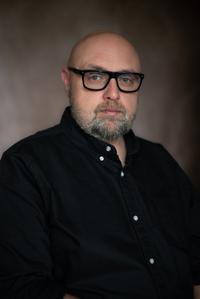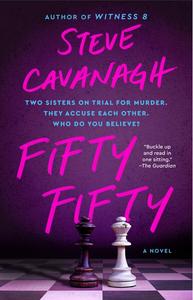
|
|
| Steve Cavanagh (photo: Emma Gornall) |
|
Steve Cavanagh is a former lawyer, and was born and raised in Belfast, Northern Ireland, where he still lives. He is the bestselling author of stand-alone thrillers and the Eddie Flynn crime novels. In 2018, the Flynn novel The Liar won the Crime Writers' Association Gold Dagger for crime novel of the year, and in 2019, the Flynn novel Thirteen won the Theakston Old Peculier crime novel of the year. The fifth book in the Eddie Flynn series is Fifty Fifty (Atria; reviewed in this issue).
Where did the idea for Fifty Fifty come from?
My wife and I spitball ideas for books often, and she had the idea of a murder trial which had two suspects. So often in mysteries and thrillers, there are multiple suspects and multiple red herrings, and I liked the challenge of just having two suspects and whether I could sustain that mystery over a whole book. So we talked some more and came up with the idea of two sisters. The book begins with each sister making a 911 call after they discover the body of their father, and each sister tells the police the other one is the real killer. That's the hook and the central challenge--could I keep the reader in the dark for a whole book?
Is there a way for you to address the question "When did you know which sister was guilty?" without giving anything away with your answer?
I wanted the reader to have the experience of reading a chapter and being totally convinced Alexandra is the real killer, then turning a page and completely changing their mind, and admitting they got it wrong, and actually Sofia is the culprit, and then flipping the reader's mind again and again and again. The structure of the novel helps with this. There are essentially three main points of view: Eddie Flynn, former con artist turned trial lawyer who represents Sofia, and young lawyer Kate Brooks, who represents Alexandra. Then there is a third point of view that is simply known as She, and it's one of the sisters, who is the real killer, but the reader doesn't know which one. That was a linguistic and logistical nightmare, but I think it really pays off. I'm a simple writer, really; every sentence, every paragraph, every page, I'm thinking about the reader and how I can entertain them and hold them in suspense until those last few pages. Did I know who the real killer was? Not until very late in the writing of the book.
Again, I'm treading carefully so as not to spoil anything, but I'm wondering if the amazing which-one-is-gonna-get-it? section in the novel came to you early in the writing process or if it was a late-breaking moment of inspiration.
That section of the book is called "The Dark Red Night." Again, it's quite simple, really. The real killer is targeting one of the main characters in the book. She is outside their home, ready to strike, and she knocks on their front door. But we don't know which front door, because then we have two different characters, in alternate chapters, who both hear knocking at their front doors. Again, it's a play on the title--Fifty Fifty. To be totally clear, I was inspired by a short sequence in The Silence of the Lambs. It's a narrative trick gained from point of view, where we expect one character to open a door, but actually it's a different character that answers a door. A much more dangerous character. Thomas Harris is a genius, and I wanted to pay homage and use this trick in my own way. I expanded this sequence over many chapters and put my own twist on it.
 Fifty Fifty strikes me as the sort of thriller that would have required an author to create something like a detective's murder board before the writing could begin. Is your method to map it out first, or do you generally leap before you look?
Fifty Fifty strikes me as the sort of thriller that would have required an author to create something like a detective's murder board before the writing could begin. Is your method to map it out first, or do you generally leap before you look?
I'm one of those terrible writers that makes the whole thing up as I go along. I have no plan, no outline, no ending, not even an idea what chapter two is going to be until I get close to finishing chapter one. It's a terrible way to write a book, but it seems to work for a lot of us.
You're a Northern Irishman, but you set the Eddie Flynn series in New York City. You told Shelf Awareness back in 2019 that, thanks to Lee Child and John Connolly, you learned that "it was possible for people outside of the U.S. to write American crime fiction.... I have a career because of those guys." But could the Eddie Flynn series have worked in another city?
I'm not sure that it would work in a different city. I write high-concept novels, the sort of mind-bending scenarios--like, what if a serial killer got onto a jury? That sort of thing. I think, for better or worse, people have a sense that anything can happen in New York. Plus the pace and the buzz of that city lends itself so well to the type of book I like to write.
It's fair to say that Flynn doesn't romanticize the legal profession. Was he conceived in response to something you thought was missing in the protagonists in other legal thrillers, or was he conceived more intuitively?
I used to be a lawyer and I remember one day conning a witness into revealing that they were lying. It struck me then that con artists and trial lawyers have identical skill sets. They manipulate, misdirect, persuade, et cetera, and that was how the character was born. I also wanted him to be an outsider so I borrowed from my own life. I'm a working-class guy from Belfast who somehow made it into the law. There are not many people like me in the profession, so I gave Eddie a similar background and made him the underdog. --Nell Beram

